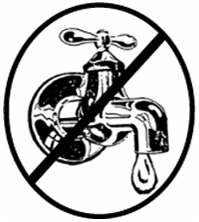
San Francisco Bay Area, California 408 227-5767
Is your tap water safe?

Did you know that a new disinfectant, chloramine, has been added to our Hetch Hetchy water system which has not been properly tested for human consumption and safety?
Are you at risk?
To find out if you are, read on!
If you have questions or concerns, contact Citizens Concerned About Chloramine (CCAC) at (408) 227-5767.
Chloramine = Chlorine + AMMONIA
If you have questions or concerns, contact Citizens Concerned About Chloramine (CCAC) at (408) 227-5767.
Chloramine = Chlorine + AMMONIA
A New Additive in the Water
On February 2, 2004, the San Francisco Public Utilities Commission (SFPUC) added a new disinfectant, chloramine, a combination of chlorine and ammonia, into the Hetch Hetchy water supply. As a result, users in the Bay area began to experience a range of reactions including:
RESPIRATORY SYMPTOMS
RESPIRATORY SYMPTOMS
- sinus and nasal congestion
- sneezing
- coughing
- choking
- wheezing
- life-threatening asthma-like symptoms
- bronchial and emphysema-like symptoms
SKIN SYMPTOMS
- rashes and red burning skin
- intense itching
- dry, chapping, flaking, cracking skin
- welts and blistering skin with scarring and pigmentation
- peeling, bleeding lips, dry mouth and throat
- dry eyes
DIGESTIVE DISORDER SYMPTOMS
- irritable bowel symptoms-like reactions (IBS)
- acid reflux-like symptoms
Neither the public nor the city water boards were consulted or involved in the decision to use chloramine in place of chlorine. The SFPUC says that chloramine is "safe" even though no one knows if it can cause cancer. Are we to be used as guinea pigs to see if chloramine in our water can cause health and other problems?
What you need to know about chloramine:
- Chloramine is a combination of chlorine and ammonia.
- Chloramine is a less effective disinfectant than chlorine and cannot kill pathogens like E. Coli and certain viruses effectively according to the World Health Organization (WHO).
- As a result, the health and lives of infants less than 6 months of age, people with suppressed immune systems such as HIV and Aids patients and those going through chemotherapy, are at risk. They must have their water boiled for over ten minutes to kill the pathogens in the water as recommended by the World Health Organization (WHO).
- The Environmental Protection Agency (EPA) states that there are NO studies on skin or respiratory effects of chloramine.
- The EPA states that the limited studies on cancer to date are inadequate. So we do not know if chloramine can cause cancer.
- Kidney dialysis patients must have chloramine completely removed from the water for dialysis treatment to prevent hemolytic anemia.
- Chloramine is difficult to remove from water. It cannot be removed by boiling, distilling, or by standing uncovered.
- Your greatest exposure to chloramine in tap water is through bathing and showering.
- Showerhead filters will not remove chloramine. A whole house or whole apartment filter with an extensive carbon filter and a reverse osmosis or cation filter is necessary and is expensive.
- Sink filters only work on cold water. A costly whole house filtration system is necessary to process all water.
- Chloramine leaches lead from pipes and lead-tin solder from pipe joints. Lead poisoning can cause neurological damage and health problems, even death in young children.
- Chloramine can pit pinholes in copper pipes. Leaks from the pipes can cause toxic molds and endanger the health of people.
- Insurance companies do not cover damage from mold. As a result, some homeowners lose their homes.
- Chloramine can corrode rubber plumbing parts such as toilet flappers, and de-elasticizes plastic polymer pipes, leaching carcinogens into tap water.
- The thousands to tens of thousands of dollars in plumbing repair costs caused by chloramine are passed on to property owners.
- Chloramine can kill fish, amphibians and water-based reptiles and marine invertebrates. Chloramine enters directly into their bloodstream, gills, or skin, literally suffocating them to death.
- Chloramine entering streams, ponds, or the SF Bay from water main breakages can cause environmental damage to fish and marine life. The Canadian EPA has deemed chloramine "toxic" to the environment (CEPA 1999).
What you can do:
- If you have health symptoms. it is best to use bottled spring water for your basic needs, such as drinking, cooking and bathing.
- Avoid bottled water from municipal sources. It may still contain chloramine even if treated.
- To determine if any cold-water sink filter will work to remove chloramine, call National Sanitation Foundation (NSF) 877-867-3435. The NSF independently tests and certifies only drinking water filtration products. You will need a whole house filtration system for bathing or showering.
- Write to your government officials and lawmakers, especially Assembly Member Ira Ruskin who works with water issues:
E-mail: assemblymember.Ruskin@assembly.ca.gov
State Mailing Address: California State Capitol, P.O. Box 942849, Sacramento, CA 94249-0001. Phone: (916) 319-2021.
Local Address: 5050 El Camino Real, Suite 117, Los Altos, CA 94022. Phone: (650) 691-2121.
Report your symptoms and concerns to CCAC President, Denise Johnson-Kula, (408) 227-5767.
Work to get chloramine out of our water supply!
CCAC's Mission Statement
Citizens Concerned About Chloramine (CCAC) is a non-profit organization whose mission is to raise the public's level of awareness about chloramine and its health effects when used as a disinfectant in the water. CCAC endeavors to pursue and support scientific studies that will explore the effects of chloramine on humans, animals and the environment. Finally, CCAC is committed to support legislation to protect the quality of water for all.
For more information or help, contact:
Citizens Concerned About Chloramine (CCAC)
(408) 227-5767 Denise Johnson-Kula, CCAC President
http://www.chloramine.org
7/06
For more information or help, contact:
Citizens Concerned About Chloramine (CCAC)
(408) 227-5767 Denise Johnson-Kula, CCAC President
http://www.chloramine.org
7/06